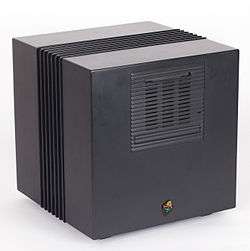Frog Design Inc.
 | |
| Private | |
| Industry | Design firm, Consulting, Innovation strategy, Industrial design, Interaction design, Software engineering |
| Founded | 1969 |
| Founder | Hartmut Esslinger |
| Headquarters | San Francisco, California, United States |
Area served | Worldwide |
Key people |
Harry West (Chief Executive Officer) |
| Owner | Altran |
Number of employees | 500+ (2017) |
| Parent | Aricent |
| Website | http://www.frogdesign.com |
Frog (styled as frog) is a global design firm founded in 1969 by industrial designer Hartmut Esslinger in Mutlangen, Germany as "esslinger design".[1] Soon after it moved to Altensteig, Germany, and then to Palo Alto, California, and ultimately to its current headquarters in San Francisco, California. The name was changed to Frogdesign in 1982 (the name apparently originating from an acronym for Esslinger's home country, the Federal Republic of Germany. Originally printed lower-case as a rebellion against German grammatical rules which other companies adapted[2]), then to Frog Design in 2000, and finally to frog in 2011.
History
In August 2004, the company announced that Flextronics International, a large electronics manufacturing services provider, was taking an equity stake in the company, a deal characterized by some commentators as essentially an acquisition. Flextronics CEO Michael Marks, in a March 2005 BusinessWeek article, said that Flex was going to integrate their San Jose-based industrial-design group with frog.[3] The company is now a unit of Aricent (formerly Flextronics Software), which in turn is controlled by investment firm Kohlberg Kravis Roberts.
First designs were for WEGA in 1969, a German radio and television manufacturer, later acquired by Sony. frog continued to work for Sony and designed the Trinitron television receiver in 1975. Their first designs for computer manufacturers were for proprietary systems by CTM (Computertechnik Müller) in 1970 and Diehl Data Systems in 1979. More prominent are the designs for Apple Computer, starting with the case of the portable Apple IIc, introducing the Snow White design language used by Apple during 1984–1990, and continuing with several Macintosh models.[4] The firm designed Sun's SPARCstations in 1989[5] and the NeXT Computer in 1987.[6]
.jpg) Apple IIc+ (ca. 1988)
Apple IIc+ (ca. 1988) NeXTcube
NeXTcube
See also
- Apple Industrial Design Group
- Tim Leberecht, Frog's former chief marketing officer
- Doreen Lorenzo, Frog's former president
References
- ↑ Hartmut Esslinger (27 May 2009). A Fine Line: How Design Strategies Are Shaping the Future of Business. John Wiley & Sons. pp. 4–. ISBN 978-0-470-50041-5. Retrieved 4 March 2013.
- ↑ Hartmut Esslinger (27 May 2009). A Fine Line: How Design Strategies Are Shaping the Future of Business. John Wiley & Sons. p. 6. ISBN 978-0-470-50041-5. Retrieved 4 March 2013.
- ↑ Online Extra: "Design Is a Commodity"
- ↑ Luke Dormehl (2 August 2012). The Apple Revolution: Steve Jobs, the counterculture and how the crazy ones took over the world. Random House. pp. 288–. ISBN 978-1-4481-3136-5. Retrieved 4 March 2013.
- ↑ David Bramston (25 November 2008). Basics Product Design 01: Idea Searching. AVA Publishing. pp. 89–. ISBN 978-2-940373-76-5. Retrieved 4 March 2013.
- ↑ Owen W. Linzmayer (2004). Apple Confidential 2.0: The Definitive Story of the World's Most Colorful Company. No Starch Press. pp. 209–. ISBN 978-1-59327-010-0. Retrieved 4 March 2013.
External links
- www.frogdesign.com — frog design (English)